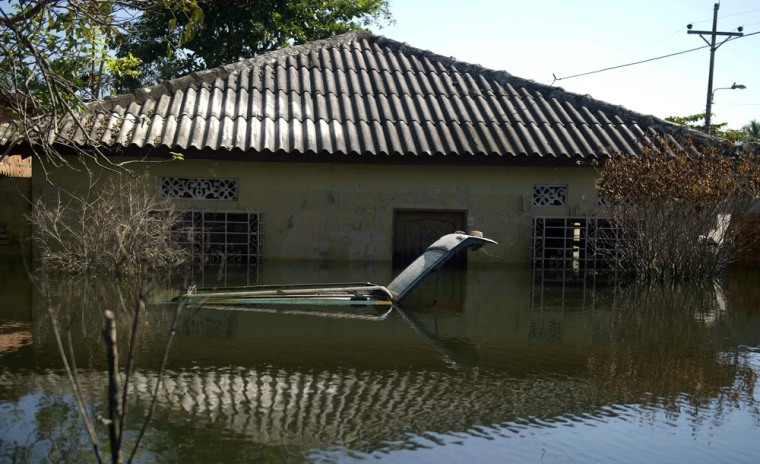Shingled rooftops poke above green, filmy water in a northern Colombian town where flooding has buried the majority of houses, avenues and parks, forcing thousands of people into shelters.
Manati has been under water since a dike broke along the Magdalena River after months of heavy rains across the Andean nation — a microcosm of the disaster that has forced 2.2 million from their homes nationwide and killed 300 more.
"Everything in the house was lost. My sister didn't have time to carry out the refrigerator, television or furniture," said Alejandro Ocampo Escobar, 58, standing almost chest deep in water as he tried to clean part of his family's pink house.
Downpours caused by La Nina weather phenomenon have battered Colombia since last year, damaging infrastructure, submerging houses and killing crops and animals in what the government calls the worst natural disaster in Colombia's history.
Colombia's tribulations add to a litany of recent flood disasters in Australia, Brazil and neighboring Venezuela.
Colombia's weather office says La Nina will continue until June, disrupting climate patterns, but rains are expected to be less than in previous months. The U.S. Climate Prediction Center says La Nina is near its peak strength.
Top foreign exchange earners such as coal and coffee have already been impacted. Coal output dropped 5 million tons below the 2010 government target, and there are fears the main coffee crop in late 2011 may be hit if the rains do not stop.
President Juan Manuel Santos' government has declared a limited state of emergency, raised some taxes, diverted budgetary money to flood relief and said it would sell part of state oil firm Ecopetrol to fund reconstruction efforts.
The government has calculated reconstruction work could cost Latin America's No. 4 oil producer between $5 billion and $7 billion and some projects could take years, but that the spending could also have a positive effect on economic growth.
In Campo de la Cruz, a town in the Atlantico department, burnt tires and smoke from torched branches mixed with the day's scorching heat — the remnants of a small riot where displaced residents living in makeshift shacks along the roadside protested, saying the government was not acting quick enough.
Police in riot gear stood nearby.
"Tell the governor to come!," said one protester. Another simply said: "We want good food."

In addition to possible security issues from frustrated people out of work and home, aid groups worry about disease outbreaks due to lack of access to sanitation and clean water.
Around 1.3 million hectares of land for food crops and pasture for animals have also been hit, raising fears of upward pressures on inflation due to rising food costs. Outside Campo de la Cruz, vultures circled around fields swollen with water — animal carcasses lay in the distance.
"In many cases people will not be able to plant or harvest crops for at least seven months. Nobody can hold out that long without the right amount of help," Guillermo Toro, Oxfam's disaster and risk reduction manager, said in a statement.
Soaked regions on the Atlantic and Pacific coasts are bracing for the start of the first rainy season around March and local officials fear there might not be enough time or money to drain deluged towns.
In Manati, also in Atlantico, waters have been slowly receding. Gerry-cans line up at the edge of the floodwaters where pumps clean water for residents—- many of whom live in tents nearby made of black plastic supported by sticks.
"There are many who say we'll be here six months but I don't believe I'll last six months. With the help of God, I have to be home in March," said Angela Escobar, 58, who was a food vendor before her house was flooded in late November.
"I pray to God every night to get rid of the water fast."
